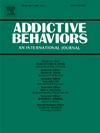Perceived harm of e-cigarettes relative to conventional cigarettes: Comparison among different measures in the US and Vietnam
IF 3.7
2区 医学
Q1 PSYCHOLOGY, CLINICAL
引用次数: 0
Abstract
Introduction
Evidence shows the inconsistencies in perceived harm of e-cigarettes between direct (single question) and indirect (assessing perceived harm separately by a single question and subtracting their score) measures. While the validity of both measures was tested by assessing their association with criterion variables (i.e., ever-trying e-cigarettes), further validation research is needed given existing limitations.
Methods
We analyzed data from Population Assessment of Tobacco and Health Study Wave 6 in the US and a provincial version of the Global Adult Tobacco Survey 2020 in Vietnam. Comparative harm of cigarettes and e-cigarettes was measured using direct and indirect method. A new criterion validity measure – “I use e-cigarettes because they might be less harmful to me than smoking cigarettes” – was introduced.
Results
In the general US population, a higher proportion of participants perceived e-cigarettes as less harmful than cigarettes when assessed using the indirect method compared to the direct method (31.56% vs. 13.70%). Additionally, although many US e-cigarette users indicated that they used e-cigarettes because they might be less harmful than cigarettes, among these people only 61.43% reported e-cigarettes to be less harmful when using the direct method but this proportion was higher (67.28%) for the indirect method. In Vietnam, this proportion was higher, at 76.68% using the direct method.
Conclusion
This study emphasizes the significance of including and reporting multiple measures within a single survey to achieve a comprehensive understanding of perceived harm.
电子烟相对于传统香烟的感知危害:美国和越南不同措施的比较。
有证据表明,直接(单个问题)和间接(通过单个问题分别评估感知伤害并减去其分数)测量方法在电子烟的感知伤害方面存在不一致。虽然通过评估它们与标准变量(即不断尝试电子烟)的关联来测试这两种措施的有效性,但鉴于现有的局限性,需要进一步的验证研究。方法:我们分析了来自美国第六次烟草与健康人口评估研究和越南2020年全球成人烟草调查的省级版本的数据。采用直接法和间接法比较香烟和电子烟的危害。引入了一项新的标准有效性措施——“我使用电子烟,因为它们对我的危害可能比吸烟小”。结果:在普通美国人群中,与直接方法相比,使用间接方法评估时,更高比例的参与者认为电子烟的危害比香烟小(31.56%对13.70%)。此外,尽管许多美国电子烟用户表示他们使用电子烟是因为它们可能比香烟危害更小,但在这些人中,只有61.43%的人表示使用直接方法时电子烟的危害更小,但使用间接方法时这一比例更高(67.28%)。在越南,使用直接法,这一比例更高,为76.68%。结论:本研究强调了在单一调查中包括和报告多种措施的重要性,以实现对感知伤害的全面了解。
本文章由计算机程序翻译,如有差异,请以英文原文为准。
求助全文
约1分钟内获得全文
求助全文
来源期刊

Addictive behaviors
医学-药物滥用
CiteScore
8.40
自引率
4.50%
发文量
283
审稿时长
46 days
期刊介绍:
Addictive Behaviors is an international peer-reviewed journal publishing high quality human research on addictive behaviors and disorders since 1975. The journal accepts submissions of full-length papers and short communications on substance-related addictions such as the abuse of alcohol, drugs and nicotine, and behavioral addictions involving gambling and technology. We primarily publish behavioral and psychosocial research but our articles span the fields of psychology, sociology, psychiatry, epidemiology, social policy, medicine, pharmacology and neuroscience. While theoretical orientations are diverse, the emphasis of the journal is primarily empirical. That is, sound experimental design combined with valid, reliable assessment and evaluation procedures are a requisite for acceptance. However, innovative and empirically oriented case studies that might encourage new lines of inquiry are accepted as well. Studies that clearly contribute to current knowledge of etiology, prevention, social policy or treatment are given priority. Scholarly commentaries on topical issues, systematic reviews, and mini reviews are encouraged. We especially welcome multimedia papers that incorporate video or audio components to better display methodology or findings.
Studies can also be submitted to Addictive Behaviors? companion title, the open access journal Addictive Behaviors Reports, which has a particular interest in ''non-traditional'', innovative and empirically-oriented research such as negative/null data papers, replication studies, case reports on novel treatments, and cross-cultural research.
 求助内容:
求助内容: 应助结果提醒方式:
应助结果提醒方式:


